














BROUGHT TO YOU BY DONOVAN LIVESTOCK & PROPERTY PH: 02 6643 4411
276 TOTAL HEAD YARDED
103 EXPORT 173 YOUNG CATTLE
A good quality yarding came forward this week with most cattle being in good condition. The market for bullocks slipped with only one processor operating however cows sold fully frm. All young cattle sold on par with previous weeks, the majority of them being better quality.
THIS SATURDAY – Bizzy & Jomanda Brahman Bull Sale, Grafton Saleyards | 11am
Cattle sales resumed at Warwick this week after the problems were fxed with the equipment and Agents saw 1210 head meet the market. The market was frm for the light feed on stock, heavy cows and steers held their ground, light feed on stock may have been a bit easier depending on type and breed.
Vealer steers av 252.1c/kg topping at 314.2c/kg or $602.20 to $829.29
Vealer heifers av 202.7c/kg topping at 248.2c/kg or $532.57 to $795.27
Feeder steers av 255.6c/kg topping at 300c/kg or $937.44 to $1613.24
Feeder heifers av 219.4c/kg topping at 248.2c/kg or $794.05 to $1277.61
Yearling steers av 249.4c/kg topping at 328.2c/kg or $758.40 to $1624.59
Yearling heifers av 204.9c/kg topping at 252.2c/kg or $629.58 to $1031.40
Steers av 248.3c/kg topping at 281.2c/kg or $1320.57 to $1617.72
Heifers av 221.2c/kg topping at 270.2c/kg or $1023.16 to $1576.26
Manufacturing steers av 220.3c/kg topping at 240c/kg or $1200.41 to $1488.00
Cows av 168.9c/kg topping at 230c/kg or $852.06 to $2162.00
Bulls av 228.7c/kg topping at 300c/kg or $1266.30 to $2682.72
Sheep and Lamb numbers increased to a total of 2509
THURSDAY 7TH SEPTEMBER 2023 – Grafton Store
Cattle Sale, Grafton Saleyards | 9am
TUESDAY 12TH SEPTEMBER 2023 – Grafton Fat
Cattle Sale, Grafton Saleyards | 8am
TUESDAY 26TH SEPTEMBER 2023 – Grafton Fat
Cattle Sale, Grafton Saleyards | 8am
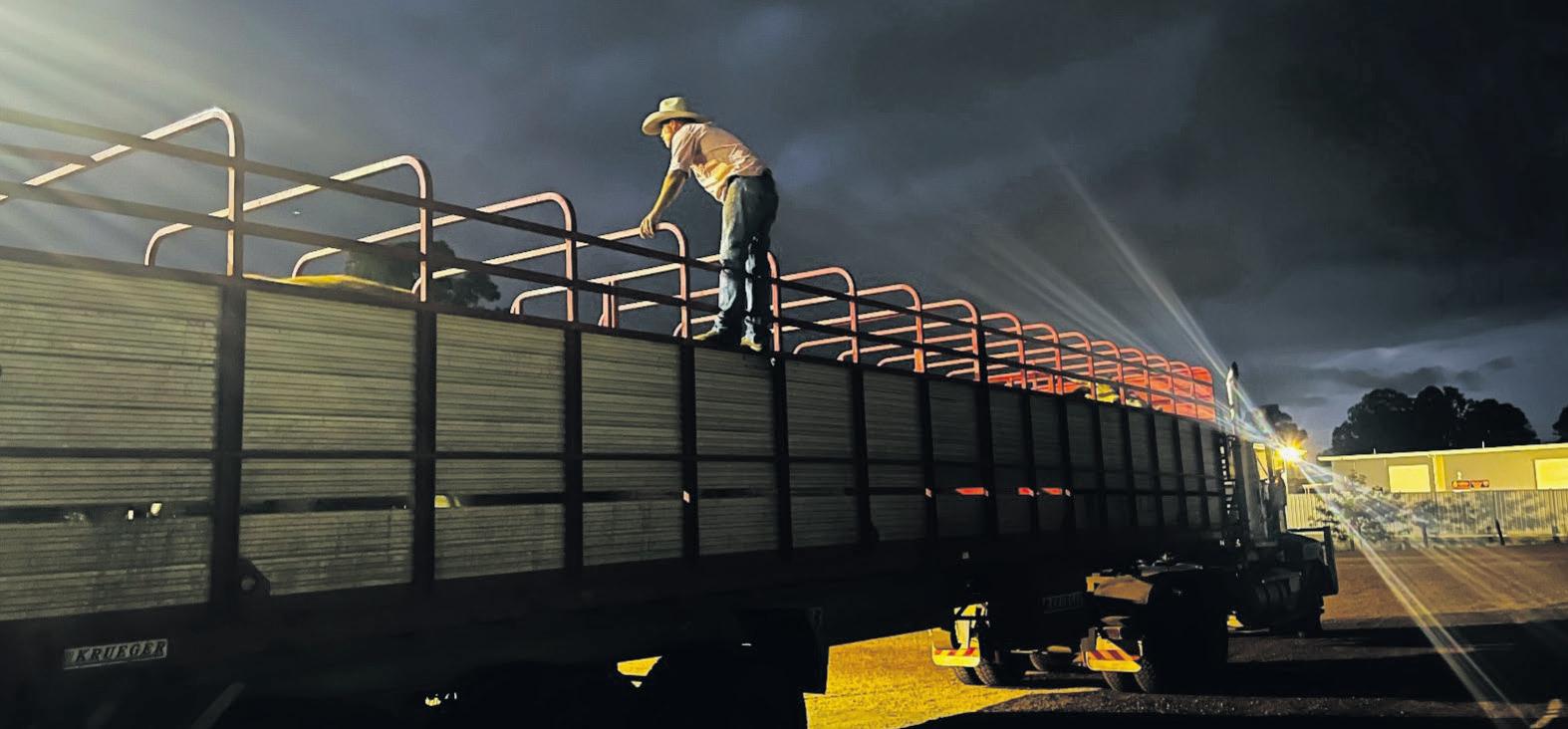
SALE HIGHLIGHTS
GRAFTON FAT CATTLE SALE
TUESDAY 29TH AUGUST 2023
head with the stock drawn from the Western regions to the Border and the New England. The lambs were approximately 50% of the yarding with Mutton in various breeds and types making up the balance.
Lambs topped at $120 to av $86.20 ($4 /head up) Hoggets topped at $100 to av $51.06 ($6 down)
Ewes topped at $75 to av $44.45 ($17down)
Wethers topped at $82 to av $52.59($7down)
Rams topped at $70 to av $30.51 (Par )
Lamb rams topped at $50 to av $33.76 ($5up)
Ewe Lambs topped at $100 to av $90.63 ($39up)
Total yarding av $67.13 a drop of $5/head week on week.
Pork & Poultry numbers were back this week.
Sows sold from $150 to $200, Baconers from $208 to $238, Light Pork to $100, Stores from $20 to $161 Poultry saw Roosters sell to $27.50, Hens to $21, Pullets to $35, Peacocks to $60, Drakes to $30, Ducks to $52.50, Bantams to $25, Groups of Ducklings to $30, Groups of chicks to $45.
Agents today yarded a total of 2509 head for the weekly sale, the stock was drawn from Western Qld to Sth West Qld as well as the New England and Border Districts. The number was nearly double last week with a higher percentage of Mutton especially in the lighter categories. lambs topped at $120 to av $86.20 ($4up), hoggets topped at $100 to av $51.06 ($6down), Ewes topped at $75 to av $44.45($17down), wethers topped at $82 to av $52.59($7down), rams topped at $70 to av $30.51(par),lamb rams topped at $50 to av $33.76($5up), Ewe lambs topped at $100 to av $90.63($39up). The sale
A/c JR Chapple sold Angus Bullocks 226.2c/kg averaged 812.5kg - $1,837.88 p/hd
A/c Springwood Grazing sold Angus/Charolais Cross Bullocks 238.2c/kg averaged 745kg - $1,776.58 p/hd
A/c Gibson Agriculture sold Devon Cross Heifers 226.2c/kg averaged 480kg - $1,085.76 p/hd
A/c Robert Quay sold an Angus Cross Cow 215c/kg weighed 695kg - $1,494.25
A/c JA & KA Clancy sold Brahman Cross Cows 211.2c/ kg averaged 571kg - $1,207.36 p/hd
A/c NA & MA Falls sold Angus Cross Steers 240c/kg averaged 415kg - $996 p/hd
A/c Southern Sky Farms Pty Ltd sold Simmental Cross Steers 220.2c/kg averaged 227kg - $499.85 p/hd
total of 2509 head av $67.13/head which was down by $5/ head from last sale.
Greenup Maryland P/S sold Dorset lambs 58kg shorn to restockers for $120 and $105, 62.5kg woolly to Thomas Foods for $117
Jukes & Sons sold Dorper lambs 56.1kg to Eversons for $111, 50.7kg to Eversons for $100, Ewe lambs 53.4kg, 52.8kg, 49.7kg, 49.3kg , to restockers for $100, Dorper ewes to Thomas Foods for $60, ewes to Eversons for $35
James Cowlishaw sold Merino wethers with a third wool skin to Eversons for $82
Gooroo Grazing sold Xbred lambs 50kg to Warwick Meats for $105, 53.5kg to Thomas Foods for $105, Dorper lambs 62.5kg to Take IT Easy Meats for $118, and Eversons for $108, 54.4kg to Thomas Foods for $108
Armstrong Family sold Dorper x lambs 49.6kg to Eversons for $108, 52kg to restockers for $108 and 52kg to GR Prime for $95, Ewes to Thomas Foods for $45, Ewes to Eversons for $22, $10 and restockers for $4
Banaba P/S sold Dorper x lambs 52.2kg to Eversons for $100, 41kg to Luck Meats for $65, Ewes to Thomas Foods for $68, Ewes to Eversons for $55
Sloss Family sold Merino wethers 61kg to Thomas Foods for $62, 54kg 4tooth to Thomas Foods for $50, 52kg Merino hoggets to Eversons for $39
Mc Dougall Family sold Dorper x lambs 53kg to Thomas Foods for $105, 49kg to Warwick Meats and Tonys Supa Meats for $100, ewes to Eversons for $30
Greg & Judy Collins sold 35.2kg Dorper lambs to restockers for $57, 35kg ram lambs to Whites Trading for $35, 25kg ram lambs to restockers for $27.
JCD Rural sold 48kg Dorper lambs to GR Prims for $100, 45kg to GR Prime for $70, Ewes to Eversons for $55
Rabobank
Beef markets around the world – other than the United States – are seeing softer consumer demand, with global cattle prices now split
softer consumer demand and “full supply chains”.
In a number of regions, particularly in Asian countries, beef purchases made through 2022 and into 2023 in anticipation of recovery from Covid
fall to their lowest levels in fve years through July. But with some rain through cattle-producing areas in July, stability returned to the market,”
Mr Gidley-Baird said.
Weekly national
cow slaughter is seeing stronger volumes exported to the US – up 103 per cent for July.
“Australian live cattle exports are down 17 per cent for the year to date (July), but we see this
The NSW Environment Protection Authority (EPA) has issued Forestry Corporation of NSW (FCNSW) an immediate Stop Work Order to cease harvesting in parts of the Tallaganda State Forest.
Following a community complaint, EPA offcers inspected several active logging compartments in Tallaganda on Tuesday 30 August and located a deceased Southern Greater Glider around 50 metres from forestry harvest operations. It is not yet known how the glider died.
identifed den trees.
“While community reports suggest around 400 Southern Greater Gliders may be living in the Tallaganda State Forest, FCNSW has identifed only one den tree and we are not confdent that habitat surveys have been adequately conducted to ensure all den trees are identifed.
“The EPA has a strong compliance and enforcement program for native forestry, and we will take immediate action where warranted, including issuing stop work orders for alleged non-compliance.”
into two distinct groups: those in North America and Europe, and those in the rest of the world, Rabobank says in its just-released Q3 Global Beef Quarterly.
The report says declining supply and strong consumer demand in the US is driving cattle prices higher, while lower domestic beef supply has also held up prices in Canada and Europe. In most other regions, however, the opposite – increased supply and lower demand – is making prices softer.
Report lead author, Rabobank senior animal protein analyst Angus Gidley-Baird said US cattle prices have increased almost 30 per cent over the past 12 months, while Australian cattle prices have dropped by more than 30 per cent.
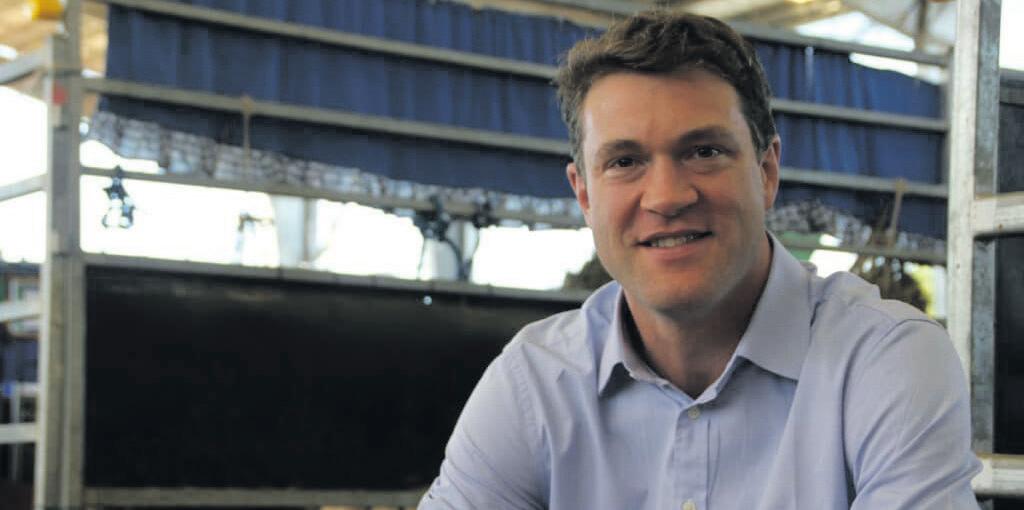
“This price spread is the largest we have seen in the past 10 years,” he said.
“Such a separation in prices will have consequences for beef exporters’ competitiveness, and we expect to see some shift in trade volumes as a result.”
A consistent theme across most markets –other than the US – is
have not been consumed, the report says. These are now part of growing stock levels that also include other proteins.
“Softer consumer demand is making it harder to move these volumes through the system,” Mr GidleyBaird said.
Australia
After falling for most o the year, Australian cattle prices had levelled out in mid-June, the report said.
Mr Gidley-Baird said the market had “seen heavy steer prices rise towards the end of July before dropping again. Meanwhile national saleyard restocker steers have drifted down slightly in August. The EYCI (Eastern Young Cattle Indicator) was down 45 per cent yearon-year for the month of August to average AUD 5.40/kg”.
Through May and June, prices had eased on producer concern about the seasonal outlook, which added additional cattle to the market, he said.
“At the same time, producer buying activity dropped as cattle numbers were building, processing capacity remains constrained and consumer markets are still soft. This saw prices
slaughter volumes for year to date (as week 33) were up 23 per cent on 2022 volumes with the increased cattle inventory fowing through to fnished cattle numbers.
“Processors remain constrained as they balance the decision to increase shifts with available cattle numbers and demand in end markets. As such, weekly cattle slaughter has been range bound at around 120,000 per week. Our expectations are that when supply chains start to clear and product starts to move more freely, given the additional cattle numbers on the ground, we will see processing capacity lift and Australian production take another step up,” Mr GidleyBaird said.
Australian export volumes rise
For Australia, the Q3 2023 Beef Quarterly says, export data for July shows beef export volumes up 30 per cent year on year.
However, Mr Gidley-Baird said, markets are mixed, with congestion generally limiting volumes to Asian markets, such as Japan, while strong demand in the US and an increase in Australian
more as a refection of lower Australian cattle numbers in northern Australia where the rebuild has been slower,” he said.
High livestock numbers
Mr Gidley-Baird notes Q2 Australian cattle slaughter numbers were up 16 per cent year on year, while 1H slaughter numbers were also up 16 per cent compared with the frst half of 2022 year.
“While not record levels, you can see that they are approaching the fve-year average and given constraints on processing capacity at the moment – these volumes will be testing throughput,” he said.


EPA Acting Executive Director Operations, Steve Orr said the discovery of a deceased glider was extremely concerning given their increased reliance on unburnt areas of the forest following the 2019/20 bushfres and its proximity to active harvest operations.
“Southern Greater Gliders are an endangered species and shelter in multiple tree cavities, known as ‘den trees’, over large distances,” Mr Orr said.
“Den trees are critical for the food, shelter and movement of gliders and FCNSW is required to protect them and implement 50 metre exclusion zones around
FCNSW has been ordered to immediately cease all harvesting, haulage operations, and any road and track construction work in the areas of concern in the Tallaganda State Forest. The order is in place for 40 days and can be extended.
FCNSW must immediately comply with the Stop Work Order. Failure to comply with a Stop Work Order is a serious offence and can attract a maximum court-imposed penalty of up to $1,650,000 and a further $165,000 for each day the offence continues. Similar penalties apply in respect of a breach of the Forestry Act.
The EPA’s investigation is ongoing.
New research using insight from virtual gaming and real-world ant battles shows how native insects can be given an upper hand against some aggressive introduced species, which could help guide non-native invasive ant management.
Dr Samuel Lymbery, who undertook this work as a Forrest Prospect Fellow with The University of Western Australia and CSIRO, Australia’s national science agency, used mathematical models on video game simulations, garnered from Age of Empires II, to illustrate how battlefeld dynamics change warfare outcomes.
These concepts were then confrmed in the real-world by observing ant battles between Australian meat ants, a native species, and smaller Argentine ants, a notorious pest.
“What we found from virtual gaming and then real-life ant battles was that mortality in the small armies of Australian meat ants facing off with large armies of non-native Argentine ants was lower in complex arenas and higher in simple arenas,” Dr Lymbery said.
“So, just like for humans, and in computer games, the outcome of ant-wars depends on the nature of the battlefeld.”

Dr Raphael Didham, Professor of Ecology in the School of Animal Biology at The University of Western
Australia and CSIRO scientist, said social insects such as ants were one of the few species to engage in warfare on the same scale as humans.
“This is because the evolutionary future of the sterile worker ants who do the fghting is invested in the greater good of the colony,”


Professor Didham said.
“We used two ant
species that clearly differed in their fghting prowess.
“Our frst combatant was the Australian meat ant, Iridomyrmex purpureus. These large

and beautiful ants are dominant in undisturbed bushland across regional Australia and construct gravelly nests.
“As their enemies, we selected the notoriously


invasive Argentine ant, Linepithema humile. These aggressive ants have been introduced to Australia and are comparatively tiny, but live in extremely large, hyper-cooperative colonies.
“Meat ants always defeat Argentine ants in one-on-one duels because of their size advantage.”
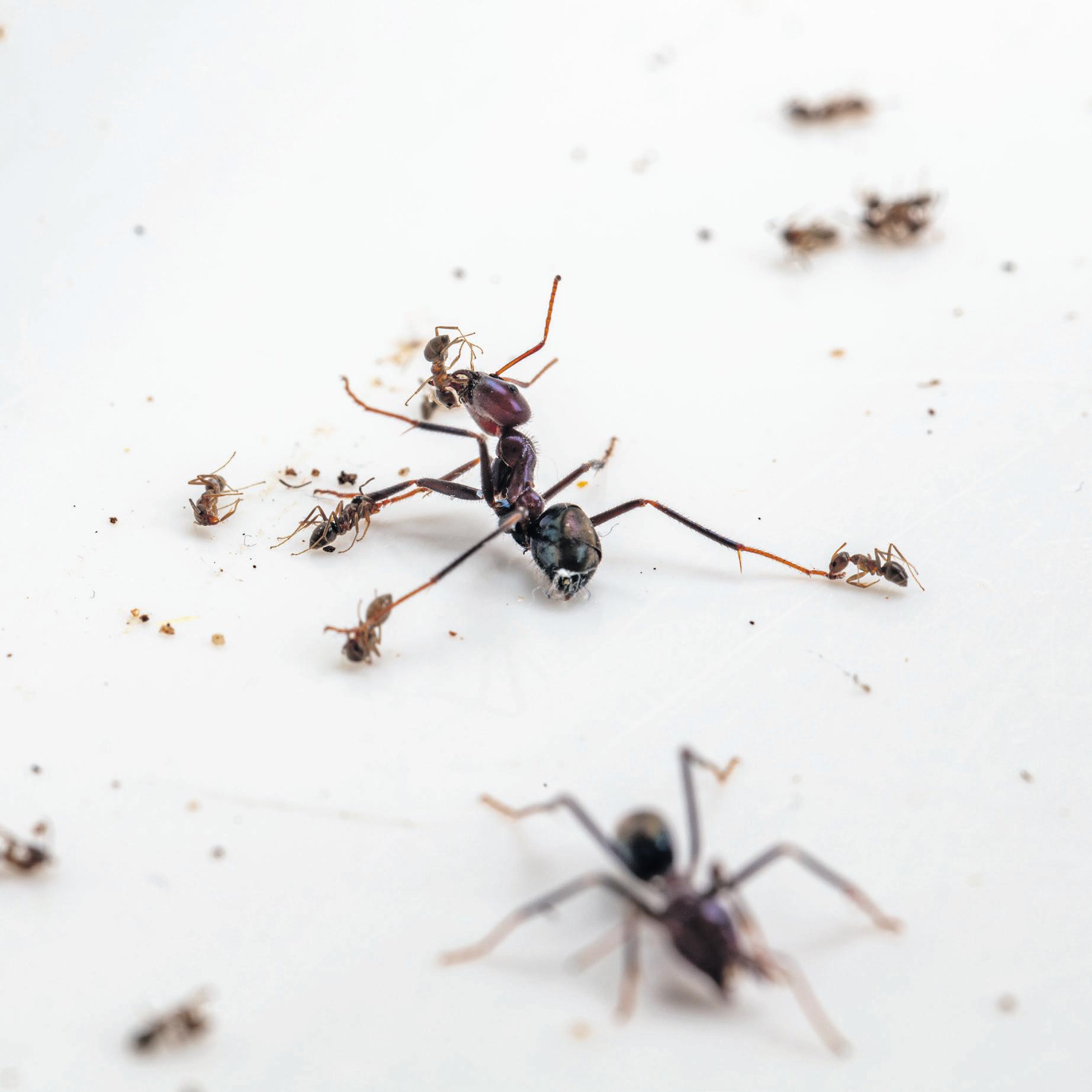
How modifying the battlefeld can dictate victory
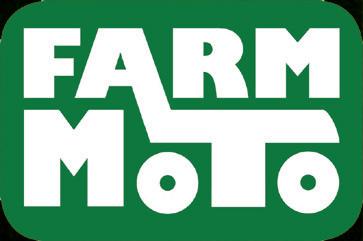
Dr Bruce Webber, Principal Research Scientist at CSIRO, said the ant battlefeld research could have practical application for non-native invasive ant management.
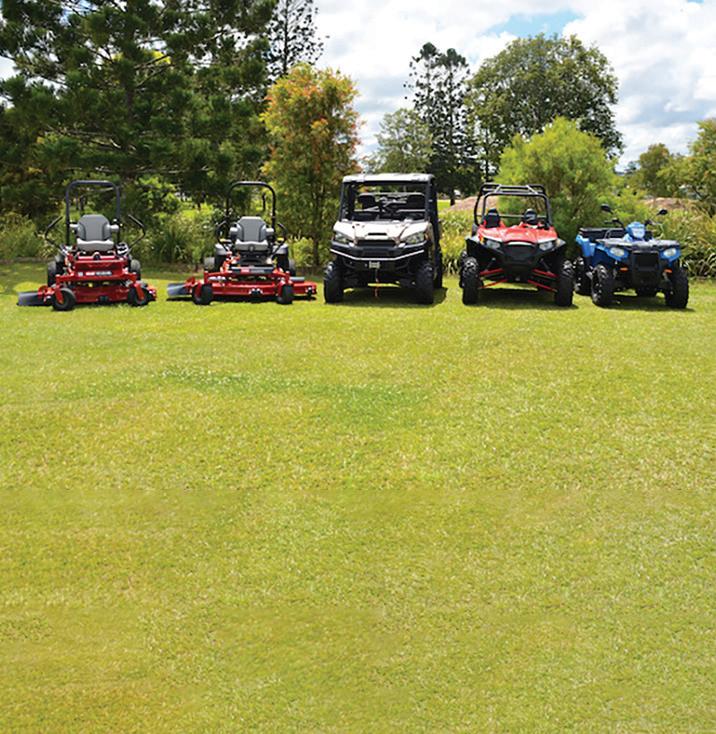
“Non-native invasive ants are some of the worst pests on the
planet, costing the global economy tens of billions of dollars per year,” Dr Webber said.
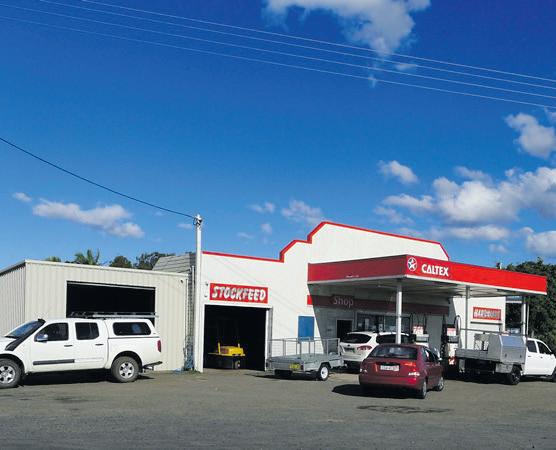


“Invasive ants like Argentine ants are typically smaller and more numerous than native species, and are often more dominant in disturbed habitats.
“Disturbed environments are often simplifed at ground level, with the removal of undergrowth and natural debris creating open battlefelds.
“This research suggests that modifying areas where native and non-native ants co-occur, by adding natural debris or other such structures, may tip the balance in favour of our larger native species.”
Dr Lymbery said by modifying natural environments the native ants were given more opportunities to succeed.
“Warfare theory suggests that fewer, stronger soldiers will be more effective when battles are a series of one-on-one duels. But larger armies are more effective when they can surround their enemies and concentrate attacks,” Dr Lymbery said.
“Battlefeld complexity can tip the balance in favour of one strategy over another.
“When fghting in tunnels, alleyways, or diffcult terrain, it is harder for large armies to surround their opponents, so small forces of strong or savvy soldiers can sometimes succeed.”
The Federal Government has inadvertently revealed that damaging water buybacks will make up at least a third of water recovery under its revised Murray Darling Basin Plan, at a starting price exceeding $3 billion.
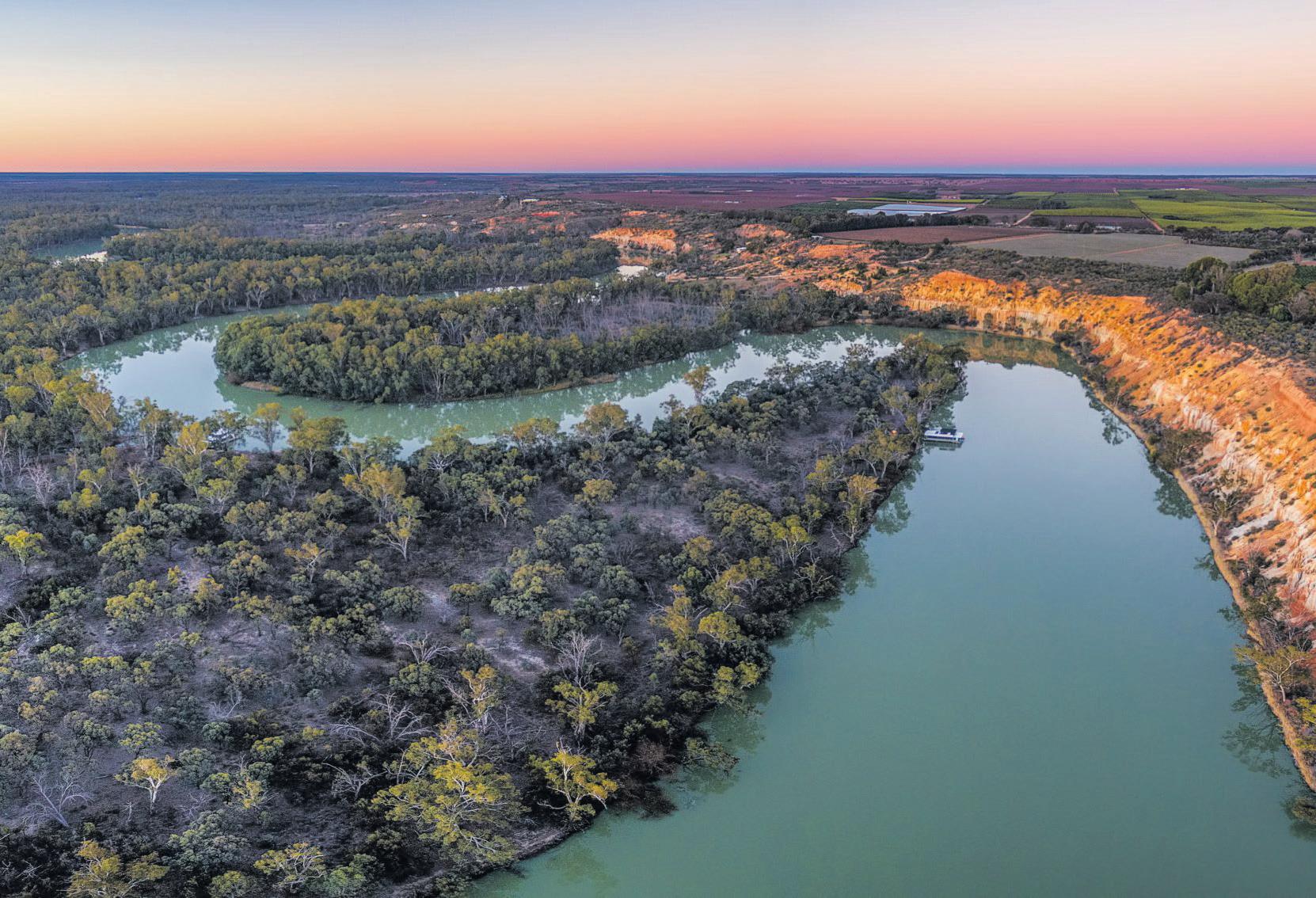
The startling revelation that government buyback spending could double under this proposal comes as serious questions emerge about how the Government will balance socio-economic impacts, and whether alternate proposals sought by the Government will be assessed before changes are brought before Parliament.
National Farmers’ Federation Water
Committee Chair, Malcolm Holm, said that in signalling a change to the legislative cap on buybacks, Minister Plibersek had shown her hand.
“The Minister has said last week the current 1500GL cap on buybacks will be lifted.
“Currently, they still have around 225GL of headroom under the cap, and a gap of 750GL to complete the plan. So by lifting the cap, the Minister is saying buybacks will exceed one third of remaining recovery.
“To launch headlong into buybacks of that scale would be devastating. Those caps and protections were put in place for a reason –
based on the maximum volume of buybacks communities could withstand.”
Meanwhile, Mr Holm said the admission that responses to a recent consultation had not yet been considered had left communities furious.
“The fact that buybacks are the focus when the Minister has over 1,000GL of buyback-free options sitting unread on her desk is a complete disgrace. The Minister is signing the death warrant for these towns and she hasn’t even reviewed the alternatives.
“Communities have done what the Government has asked here – they have done the legwork to give the Minister options. Instead
of acting in good faith and in a transparent way the Government is demonstrating it doesn’t care about farmers or communities.
“Those options should be given the time of day before blowing up the Plan and spending billions shutting down farms.”
Mr Holm said he remained hopeful that Parliament would force accountability and demand answers to important questions.
“As it stands, Minister Plibersek is asking the Parliament to sign a blank cheque to shut down farms. We think the cost to taxpayers will have to exceed $3 billion, but that’s just our estimate. We’re left
guessing because there’s no transparency.
“Both the Parliament and the community deserve better. They ought to have clarity on the extent of buybacks proposed, how socioeconomic impacts will be considered, and what engagement will occur to give communities a voice in this process.”
The NFF has written to Minister Plibersek posing 13 initial questions that now need answering in the wake of the Government’s initial announcement.
“There are a lot of gaps in information at the moment. That makes communities nervous, it makes food processors nervous, and it makes people who work in our
industries fear for their jobs.
“When state governments start leaving the table or participating conditionally based on community concerns, you know what’s been agreed is a bad deal. The question now is how bad, and can the Parliament step in to correct the course?
“We all want to see the plan complete, but we have a choice in how to get there. We want to see it done the smart way that delivers the water needed without taking food off the table in the middle of a cost-ofliving crisis,” Mr Holm concluded.
A new catch and release sportfshery at Porters Creek Dam near Milton on the NSW South Coast is expected to become a popular destination for local and visiting anglers.
NSW DPI Fisheries Deputy Director General Sean Sloan said that the new fshery is the result of close work between the NSW Department of Primary Industries (DPI) and Shoalhaven City Council.
“This is a new and exciting fshing catch and release location where anglers can target native Australian Bass,” Mr Sloan said.
“This new catch and release sportfshery has opened just in time
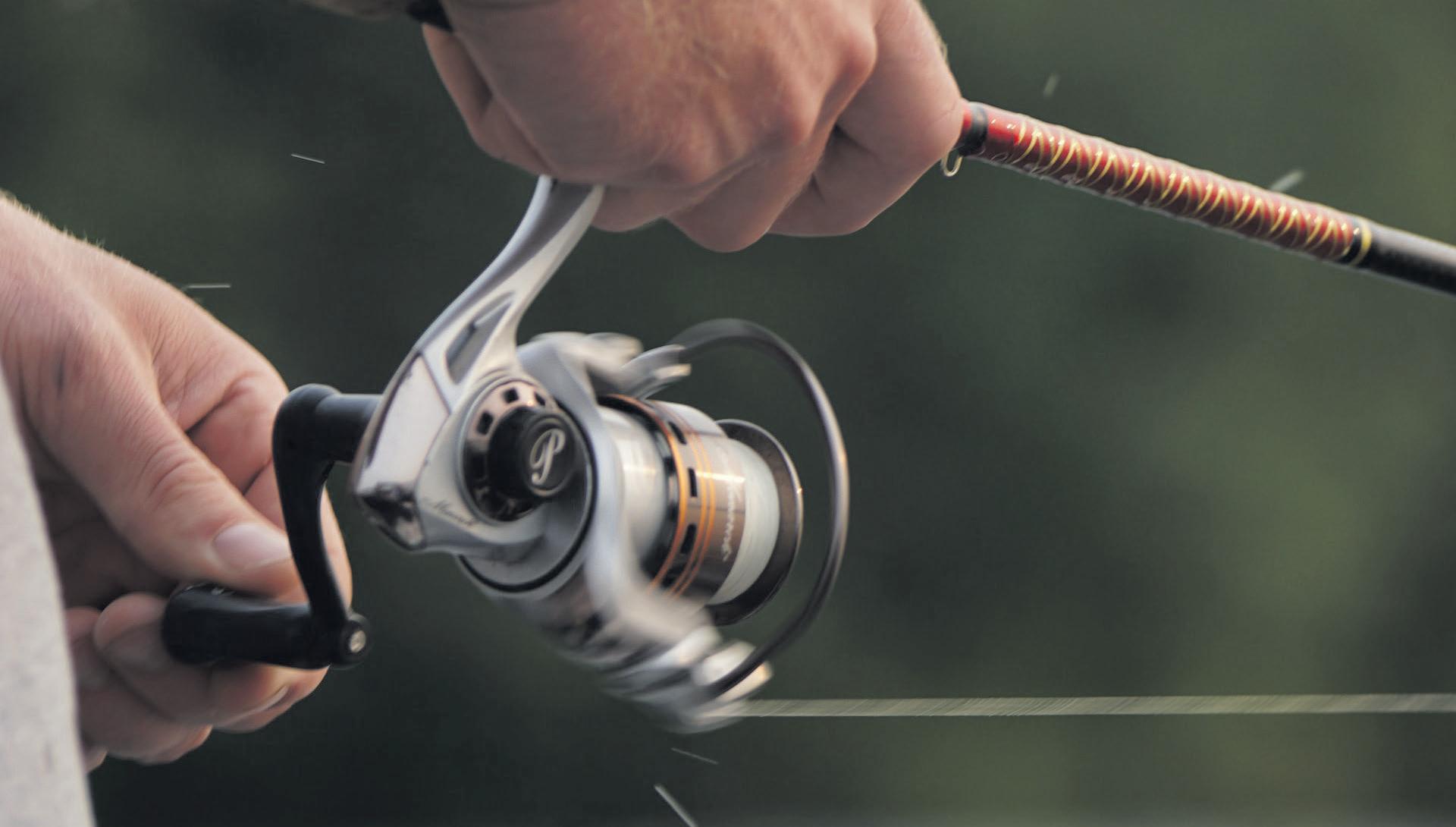
for the Australian Bass season opening on 1 September.
these iconic sportfsh.
“The work by DPI and Shoalhaven City Council



provide opportunities that can be enjoyed for generations to come.”
Shoalhaven City Council to maintain and promote fshing access at the dam.
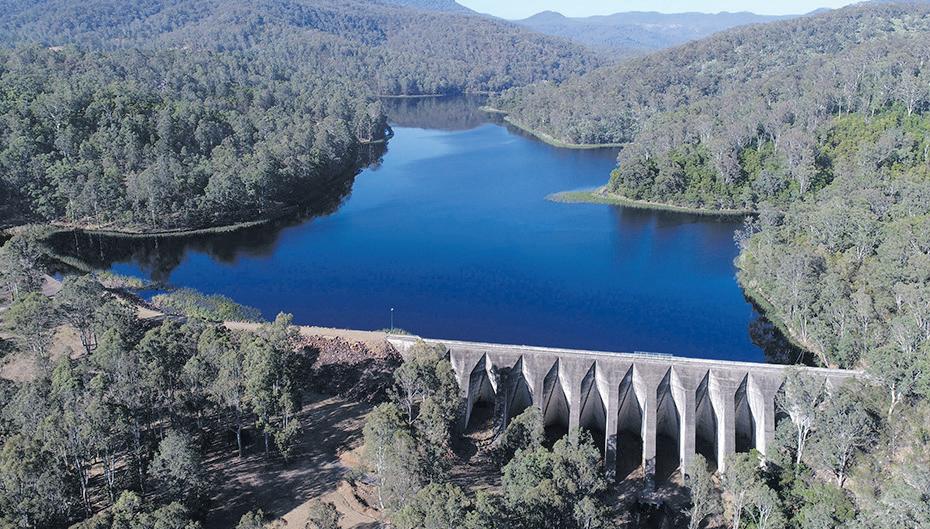
“The dam will be managed in collaboration with the council as a catch and release fy and lure only fshery, that is, no bait fshing allowed,” Mr Sloan said.
“New signage will also




that the public is aware of these changes.
“DPI Fisheries Offcers will also be patrolling the area to ensure that these rules are being followed.”
“Stocking of juvenile Australian Bass in the dam has previously been undertaken by NSW DPI with assistance from the Shoalhaven Council.
“This work is part of the Native Fish Stocking program and has successfully established a productive fshery for

to create a new fshery at Porters Creek Dam will
Mr Sloan said DPI will continue to work with

be installed at Porters Creek Dam to ensure
DPI’s fsh stocking and access programs are supported with funds from the Recreational Fishing Trust and is a great example of fshing licence fees being re-invested back into improving recreational fshing.
The public is encouraged to report illegal or suspected illegal fshing activity to the Fishers Watch Phoneline on 1800 043 536 or report online via the form at: https://fal. cn/3gJWh
Critical habitat for the endangered Greater Glider is being logged in Tallaganda State Forest on the South Coast of NSW by Forestry Corporation despite it being one of only two large areas of habitat to have survived the 2019/20 bushfres. The World Wildlife Fund, Wilderness Australia and NSW Greens MP Sue Higginson have all written to the Minister for the Environment, Penny Sharpe, calling for an immediate stop to work in Tallaganda Forest while independent surveys can establish the location of Greater Glider habitat trees.
“The logging of Greater Glider Habitat in Tallaganda State Forest could be the nail in the coffn of extinction for Greater Gliders,” Greens MP and Spokesperson
for the Environment said. “Just last week the Biodiversity Conservation Act Review was tabled in Parliament and found that the laws in NSW are failing the environment and that native forest logging is damaging forest ecosystems and the habitat of native species. Now here we are looking at state sanctioned extinction logging underway in habitat that is critical to the survival of the endangered Greater Glider.
“Forestry Corporation have only recorded a single Greater Glider den tree in the 5,000 hectare area that they intend to log, this is completely at odds with most reports on the Greater Glider population in Tallaganda that show this population is just one of two large
populations remaining in the State.
“The Minister must use her powers to order a halt to the logging operations in Tallaganda so that this vast discrepancy in population reporting can be resolved, Forestry Corporation have either failed to conduct adequate surveys or they are willfully misleading the Government and people of NSW.
“The independent review of the Biodiversity Conservation Act headed up by Ken Henry AC explicitly stated that laws that have an objective to protect the environment must take precedence over laws that facilitate environmental harm. What is happening in Tallaganda is precisely what the review says needs to change.
Forestry Corporation have compiled with the letter of the Forestry Act and are now logging critical remnant habitat of an endangered species with impunity. We can’t keep destroying the habitat of species that are on the brink of extinction.
“I’ve written to the Minister and called for her to intervene now, to keep her promise of no new extinctions in NSW, because without the Government taking action now, Greater Gliders will be reduced to just one large population area in the entire state.
“If logging in Tallaganda continues, Greater Gliders will be pushed to extinction and this Government will be looking down the barrel of its own political failure.
For the week ending 30 August 2023, fronts and troughs brought isolated showers to south-eastern parts of the country. A high-pressure system kept the remainder of the country dry and clear.
Across cropping regions, rainfall totals of up to 15 millimetres were recorded in isolated areas in north-eastern New South Wales. Little to no rainfall was recorded in the remaining cropping regions. Given the lack of rainfall across many cropping regions in New South Wales, Queensland and Western Australia, these regions are continuing to see a gradual decline in soil moisture reserves. This represents an increased risk of declines in crop yields if follow-up rainfall is not received in the next few weeks.
The Bureau of Meteorology’s ENSO outlook remains at El Niño ALERT given that not all atmospheric indicators have reached El Niño thresholds. The sea surface temperature has exceeded El Niño thresholds in the tropical Pacifc. The Southern Oscillation
Index is just below El Niño thresholds. In contrast, trade winds and cloudiness near Date Line are fuctuating closer to average and are yet to reach El Niño thresholds.
The Indian Ocean Dipole (IOD) index has been in the positive phase for the past two weeks, but this has to persist for several weeks to be declared a positive IOD event. A positive IOD, together with an El Niño, typically suppresses spring rainfall in central and eastern Australia. The expected onset of these climate drivers is infuencing the hot and dry outlook for spring.
Over the 8-days to 7 September 2023, fronts and troughs are expected to bring isolated showers to southern parts of the country. A high-pressure system is expected to bring mainly dry conditions to the remainder of the country.
Across most cropping regions, minimal rainfall totals of up to 10 millimetres are expected. These falls are not expected to have much beneft to crops and pastures as they are
unlikely to be suffcient to offset evaporative losses. Cropping regions in Queensland, northern New South Wales, northern Western Australia and western South Australia have experienced a dry August to date and have well below average levels of soil moisture. Crops and pastures in these areas will be disposed to heat and moisture stress, negatively affecting production potential.

Water storage levels in the Murray-Darling Basin (MDB) increased between 24 August 2023 and 31 August 2023 by 36 gigalitres (GL). Current volume of water held in storage is 21 026 GL. This is 2 percent or 457 GL less than at the same time last year.
Allocation prices in the Victorian Murray below the Barmah Choke remained steady at $155 from 24 August 2023 to 31 August 2023. Prices are lower in the Goulburn-Broken and regions above the Barmah choke due to the binding of the Goulburn intervalley trade limit and Barmah choke trade constraint.
One year on from the Federal Government’s Jobs and Skills Summit, the crippling workforce shortages facing Australian vegetable growers have only worsened, and many growers are now reconsidering their future as vegetable producers.
An alarming sentiment survey conducted by AUSVEG, the vegetable peak industry body, has revealed recordlow morale among Australian vegetable growers, with labour shortages, workforce policy and legislative changes, increased compliance and rising operational costs major factors forcing growers to contemplate their commercial viability.
Appearing at the Senate Inquiry on Food Security in early August, AUSVEG highlighted how increasing costs of production, tightening margins and chronic labour shortages are making vegetable growers question their future in the sector, with more than 30 per cent of Australian vegetable growers now considering leaving the industry within the next 12 months.
The survey also highlighted that:
• 72 per cent are currently experiencing workforce shortages.
• 45 per cent rate their future viability with current workforce shortages as ‘poor to very poor’.
Ahead of the one-year anniversary of the Jobs and Skills Summit on Friday 1 September, the issues raised by AUSVEG in Canberra around workforce availability have still not been addressed, and are expected to deteriorate due to Labor’s recent policy changes that will narrow workforce options.
These new policies were a key concern highlighted by many growers in AUSVEG’s survey. The Working Holiday Maker program, PALM Scheme and overseas student visas, which allow Australian farmers to fll critical labour shortages with overseas workers, have all undergone signifcant changes in recent months.
AUSVEG CEO
Michael Coote said the dire survey results were not overly surprising given the signifcant challenges that growers had faced over recent years.
“We’re a year on from the Jobs and Skills Summit, and unfortunately the only changes the Government have made in that time are making the problem worse, not better,” said Mr Coote.
“Fire, drought, food, rain, hail, labour shortages, volatile markets, biosecurity breaches, unprecedented cost increases to inputs, and many other issues can have detrimental impacts on farmers and rural communities.”
“The toll is showing on
vegetable growers, and if even close to 30 per cent of them move away from vegetable production, frequent fresh produce shortages will become the new norm, and Australian families will bear the brunt with higher prices for their produce.”
“While the Agriculture Minister is trying to work with industry, the Albanese Government has not acted on feedback from growers when they’re already being crushed by rising input costs, severe weather and price pressure from the retailers, among other challenges.”
“Vegetable growers just want to be able to grow healthy produce and remain competitive in an increasingly complex business environment, but without an adequate supply of workers, there is a risk that fresh produce will not be planted and families will face higher food costs.”
AUSVEG is calling on the Federal Government to genuinely work with the vegetable industry on workforce policy reforms that uphold the highest standards of worker welfare while also meeting the needs of growers.
“The Australian vegetable sector is forecast to grow by at least an additional billion dollars in annual farm-gate value by 2030, but if we’re hamstrung by workforce availability that potential to grow the Australian economy will be lost,” said Mr Coote.
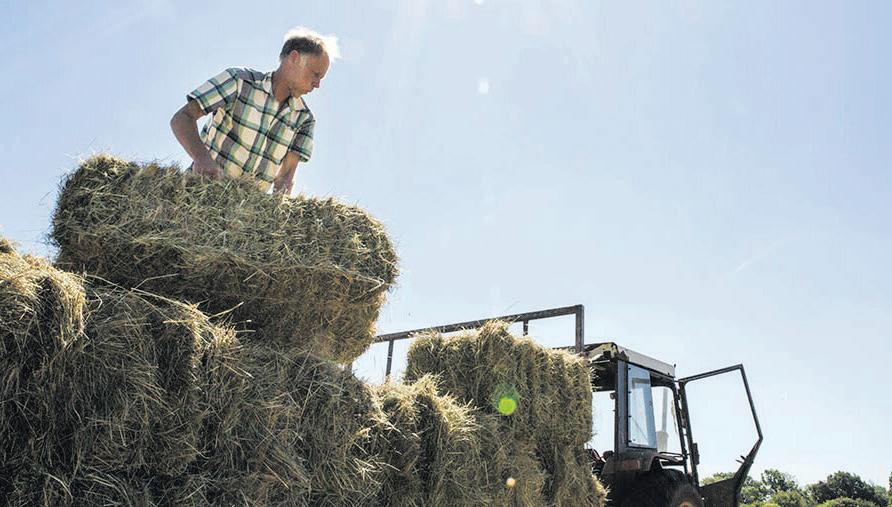
©Commonwealth of Australia 2023, Australian Bureau of Meteorology Issued: 30/8/2023
Note: The rainfall analyses and associated maps utilise data contained in the Bureau of Meteorology climate database, the Australian Data Archive for Meteorology (ADAM). The analyses are initially produced automatically from real-time data with limited quality control. They are intended to provide a general overview of rainfall across Australia as quickly as possible after the observations are received. For further information go to http://www.bom.gov.au/climate/ rainfall
NSW Department of Primary Industries (NSW DPI) will allow beekeepers to move beehives out of recently declared surveillance (purple) zones in almond pollination areas to manage biosecurity risks.
NSW DPI Chief Plant Protection Offcer Shane Hetherington said the recent identifcation of four Varroa mite infestations at Euston, Euroley, Nericon and Balranald had triggered the creation of eradication (red) and
surveillance (purple) emergency zones.
“We know the infested hives we have identifed by tracing movements from the Kempsey region have only been in these almond orchards for a short time and with plenty of foral resources the bees would not have travelled far,” Dr Hetherington said.
“That means the risk of them transferring mites to hives outside the red zone to hives in the purple zone is negligible.
“However, the foral resources are rapidly


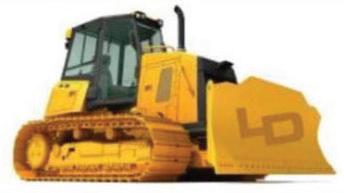
running out as the almond orchards fnish the fowering period and bees will begin to rob neighboring hives which creates a signifcant biosecurity risk.
“The Emergency Order would normally prevent the movement of all surrounding hives out of eradication and surveillance zones as a precaution.
“We’ve conducted a thorough risk assessment and amended the Emergency Order to allow movement of hives out of the four new surveillance (purple)
zones to reduce the chances of bees from those few infested hives mixing with bees from other hives and spreading the mite.”
Changes to the Emergency Order introduced today allow beekeepers to move hives out of the four surveillance zones at Euston, Euroley, Nericon and Balranald, provided:
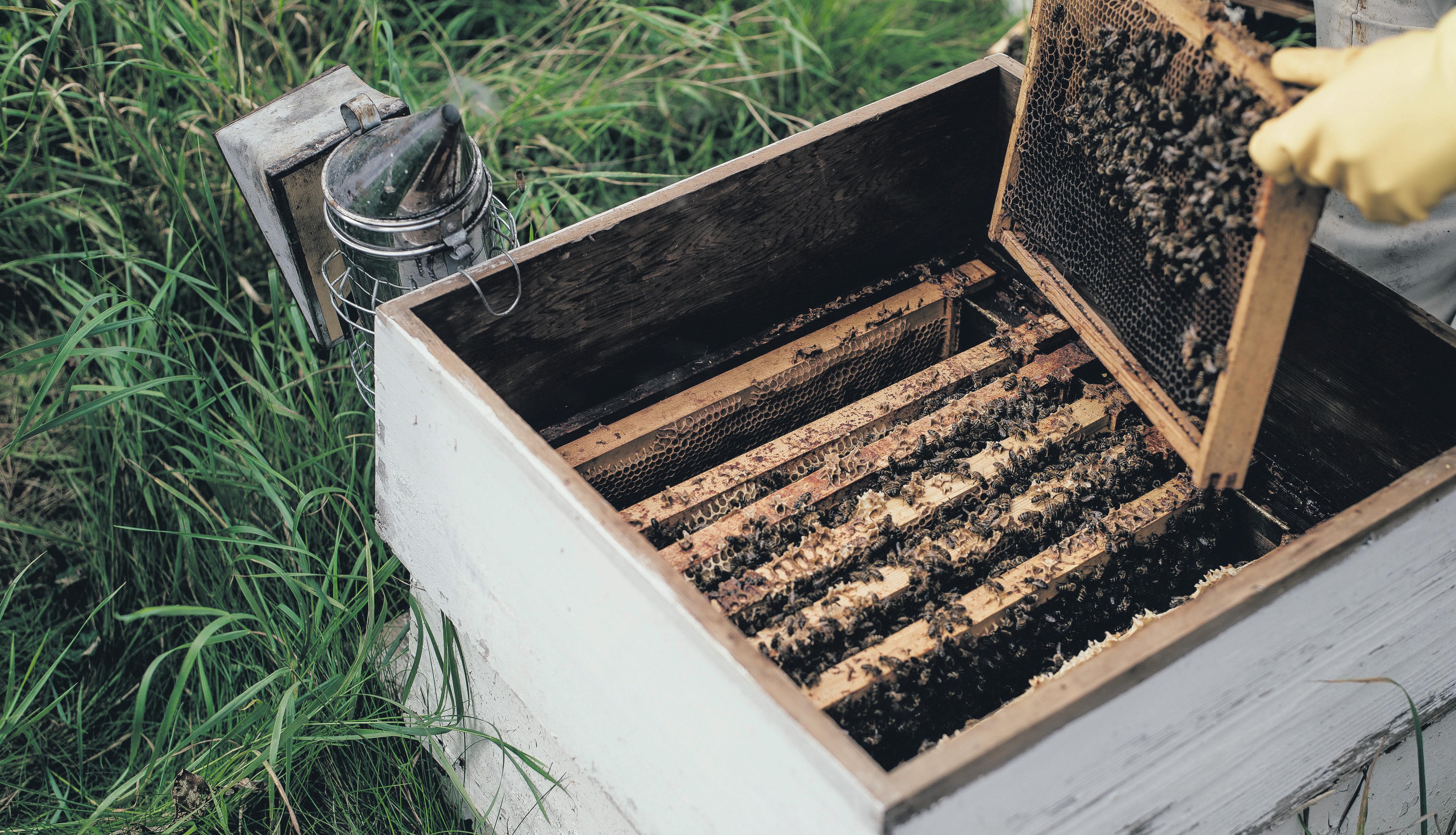
• The beekeeper lodges a movement declaration via Movement of bees (nsw.gov.au) for each load of bees PRIOR to movement

• The hives are moved to a General Emergency (blue) zone site
• Hives are moved directly to the destination site and not moved off that site until approved by NSW DPI
• Beekeepers must carry a copy of the hive movement declaration with them for the duration of the move
• The beekeeper alcohol washes up to 64 hives on arrival and reports the results to NSW DPI
• The beekeeper takes and retains
photograph of at least one alcohol wash which is time and datestamped and shows the approximate location
• Beekeepers should refer to the Emergency Order for full details of movement requirements
These changes do not allow movement of hives out of any other NSW surveillance (purple) or eradication (red) zones. Sites that receive hives from the four purple zones will be monitored by NSW DPI.